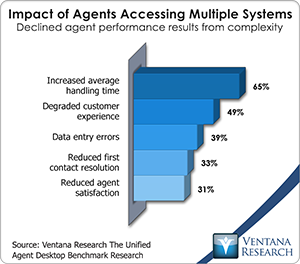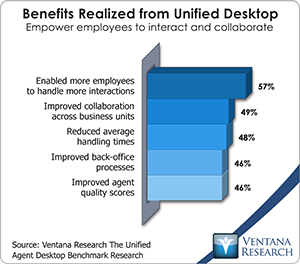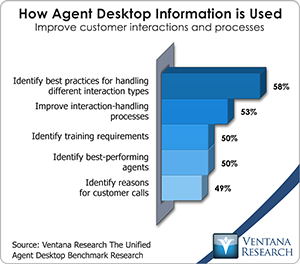My research into the customer service agent desktop shows that most centers expect a lot of their contact center agents: more than half (59%) handle between two and five different services (such as general queries, complaints and sales) and 14 percent handle seven or more. Nearly half (49%) are expected to handle between six and 15 calls per hour, and as well as calls, the majority (75%) are expected to handle other forms of interactions, with most handling between one and five per hour. To achieve these goals most agents (65%) have to access an average of three or four different business applications, as well as multiple communication channels and dashboards. To make matters worse, a minority (28%) still have to use multiple desktops to access these systems, and the majority (62%) have to sign into each system independently. It is therefore not surprising that only a third (35%) of respondents believe their agents are satisfied with their roles.
The complexity of the agent desktop has a significant impact on agent performance, with companies on average seeing deterioration in performance in just over two areas. The majority see a direct impact on average call handling times, with less than fifth (17%) seeing agents always meeting this key target, while a small number of cases (3%) never see agents hit their target. As agents have to navigate across systems and through multiple screens within systems as they try to resolve customer interactions, 39 percent of companies experience agents making errors as they enter new data, and for 33 percent the complexity reduces the number of interactions resolved at the first attempt. This difficulty, and the generally low level of agent satisfaction, has a serious adverse impact on the customer experience for nearly half (49%) of companies. This in turn has a negative effect on three key customer-related metrics: customer satisfaction, net promoter and customer effort scores.
performance, with companies on average seeing deterioration in performance in just over two areas. The majority see a direct impact on average call handling times, with less than fifth (17%) seeing agents always meeting this key target, while a small number of cases (3%) never see agents hit their target. As agents have to navigate across systems and through multiple screens within systems as they try to resolve customer interactions, 39 percent of companies experience agents making errors as they enter new data, and for 33 percent the complexity reduces the number of interactions resolved at the first attempt. This difficulty, and the generally low level of agent satisfaction, has a serious adverse impact on the customer experience for nearly half (49%) of companies. This in turn has a negative effect on three key customer-related metrics: customer satisfaction, net promoter and customer effort scores.
To address these issues, just over a quarter (29%) of companies have implemented what we call a unified agent desktop – that is, a system that allows companies to declutter the agent desktop, make it easier to access systems, and provide capabilities to support agents as they try to resolve customer interactions. The top three capabilities these companies looked for were the ability to access collaboration systems, a view of all customer information and access to real-time operational information.
 By deploying such a system, companies have achieved several benefits. The primary benefit has been to enable more employees to handle more interactions, and companies have been able to use the collaboration capabilities found in most desktop systems to improve collaboration across the organization. These are both key benefits, because my research into the contact center in the cloud shows that organizations are distributing interactions to more employees in more locations, including home agents, mobile workers and knowledge experts in other lines of business, and having a smart desktop enables these employees to work without regard to location yet deliver the same customer experience. The smart desktop enables employees to collaborate to resolve interactions, which has a positive impact on first-contact resolutions rates. While these are key benefits, before investing in such a system many companies struggle building a business case, because it is often difficult to monetize such benefits. However, one of the other major benefits companies have seen is a reduction in call handling times, and a reduction here is quite easily monetized because it is directly linked to the number of agents required to handle the volume of customer interactions.
By deploying such a system, companies have achieved several benefits. The primary benefit has been to enable more employees to handle more interactions, and companies have been able to use the collaboration capabilities found in most desktop systems to improve collaboration across the organization. These are both key benefits, because my research into the contact center in the cloud shows that organizations are distributing interactions to more employees in more locations, including home agents, mobile workers and knowledge experts in other lines of business, and having a smart desktop enables these employees to work without regard to location yet deliver the same customer experience. The smart desktop enables employees to collaborate to resolve interactions, which has a positive impact on first-contact resolutions rates. While these are key benefits, before investing in such a system many companies struggle building a business case, because it is often difficult to monetize such benefits. However, one of the other major benefits companies have seen is a reduction in call handling times, and a reduction here is quite easily monetized because it is directly linked to the number of agents required to handle the volume of customer interactions.
As I pointed out in an earlier post, digging into the results of the research shows another direct impact of deploying such an agent desktop system. The unified desktop has a major impact on agent satisfaction, and agent satisfaction has a direct impact on whether agents meet key metrics. The research shows that by linking the results, a smart desktop improves agent satisfaction, and happier agents are twice as likely to meet key customer-related metrics – customer satisfaction, net promoter and customer effort. Since these measures have become the focus of many organizations, the combination of reduced handling times and improvements in all three metrics should make a compelling case to invest in such a system.
Although they are not directly connected, many organizations that have deployed a unified desktop system also deploy desktop analytics, because the combination can deliver even greater business benefits. Desktop analytics work by capturing activity at the agent desktop and providing companies with an analysis of what systems agents access, what data they enter and the outcome of their efforts. Organizations can thus compare how different agents handle different interactions, determine best practices and use the information to improve the processes. The combination of technologies therefore allows companies to close the loop by understanding what is happening, building improvements into the desktop, and assessing the impact. Furthermore, organizations can better focus agent training on areas the analysis shows to be weakest and thus get more agents to follow best-performing agents.
deployed a unified desktop system also deploy desktop analytics, because the combination can deliver even greater business benefits. Desktop analytics work by capturing activity at the agent desktop and providing companies with an analysis of what systems agents access, what data they enter and the outcome of their efforts. Organizations can thus compare how different agents handle different interactions, determine best practices and use the information to improve the processes. The combination of technologies therefore allows companies to close the loop by understanding what is happening, building improvements into the desktop, and assessing the impact. Furthermore, organizations can better focus agent training on areas the analysis shows to be weakest and thus get more agents to follow best-performing agents.
My last assessment of desktop vendors shows that several vendors have been providing unified desktop systems for many years, and some now include features to make their systems smarter, by advising agents on next best action, pointing at data that needs updating and displaying all previous interactions. This is why I am busy assessing the latest releases of products from 2012 to determine how they are adapting to customer requirements and deliver the best possible benefits. However, the research shows that only about a quarter of organizations have so far seen the benefits such systems can deliver.
Many people are now writing and talking about the need to empower agents and deliver great customer experiences. I believe that, combined with more focused training, the unified or smart desktop is the best and perhaps only way to archive this. I urge companies to investigate how they can support their efforts to make interaction more efficient and effective.
Regards,
Richard J. Snow
VP & Research Director












